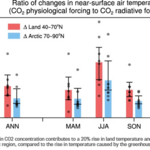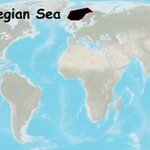Oceanography

There has long been debate about the role of Earth’s orbit in driving global climate cycles. As most people know, 90,000 of every 100,000 years have been ice ages in patterns.
Scientists have long been aware that the waxing and waning of massive Northern Hemisphere ice sheets results from changes in the geometry of Earth’s orbit around the Sun. A new study has been able to pinpoint exactly how the tilting and wobbling of the Earth as it orbits around the Sun has influenced the melting of ice sheets in the Northern Hemisphere over the past 2 million years.
There are two aspects of the Earth’s…

Water has varied in temperature for as long as water has existed and it seems evolution has provided coral reefs a recovery mechanism after variation results in 'bleaching' - when corals expel algae and turn white. It can have some impact beyond algae because about 275 million people live near a coral reef and they can be tourist attractions and help support fishing industries.
In 2018, two years after the government protected Chagos Archipelago underwent bleaching, the reef coral cover and carbonate production were down by more than 70 percent. Yet by last year, they were found to have…

San Francisco is worried that highway 37 may be in danger of flooding. They invoke environmental justice, of course, but it's really about rich people going to their second homes in Napa's wine country on weekends. Rich people need peasants toiling to feel elite and without roads they can't get there.
Yet if San Francisco journalists and editors are concerned about rising water, why are they continuing to support dumping the water that poor people need into the Bay? It clearly does not need more water. Poor people who can't afford to live in Napa do.
Thanks to laws their own political party…

The Red Sea is about 1000 miles long and at most just over 170 miles wide. The Greeks called it a sea but they also called the Persian Gulf a sea.
It may instead be an ocean, because an ocean basin exists between Africa and the Arabian Peninsula. The Greeks did not know that and the problem in knowing now is that the oceanic crust along the narrow, north-south aligned rift is widely buried under a thick blanket of salt and sediments, which complicates direct investigations.
A study says it makes a good case for the Red Sea not only an ocean but being quite mature and having an almost…

Satellite data with on-the-ground observations over two summers in Antarctica to detect and measure the green snow algae have led a group of scientists to suggest that if the world warms, larger fields of bright green snow could be seen from space as it spreads.
Antarctica is the world's southernmost continent, typically known as a frozen land of snow and ice. But terrestrial life can be abundant, particularly along its coastline. Although each individual alga is microscopic in size, when they grow en masse they turn the snow bright green.
That already happens, snow algae are a key component…

A new paper has implicated a physiologic mechanism in vegetation as a cause for Arctic warming.
The "greenhouse effect" is well-known by now, water vapor that plants emit during photosynthesis serves to lower land surface temperature, similar watering the yard on a hot day, but it can lead to a rise in air temperature.
The new paper finds that the Arctic temperature rises when the moisture released by plants is reduced due to the increase of carbon dioxide (CO2 ) in the atmosphere. The increase in atmospheric CO2 concentration closes the pores (stomata) of plants in high-latitude areas and…

Though we convert fat, protein, and carbohydrates to make our common ATP energy currency, microbes have a far more diverse diet.
It turns out a new one can even digest organic compounds like ethane, the second most common component of natural gas.
In the seafloor of the Guaymas Basin at a water depth of 2000 meters in the Gulf of California, a new archaea named Ethanoperedens thermophilum ("heat-loving ethane-eater") has been discovered, and it can also convert carbon dioxide into ethane.
Some natural gas components such as propane or butane can be broken down by bacteria alone. However…

A new review finds a dramatic increase in the abundance of a worm that can be transmitted to humans who sushi - 283-fold more since the 1970s
But is that due to better detection or a real increase? And what implications does it have for humans and marine mammals?
The herring worm, Anisakis, is found naturally in a variety of marine fish and squid species. They are less than an inch long, but that is obviously large in a fish, so seafood processors and sushi chefs are well-practiced at spotting them and picking them out before they reach customers. Some will still make it through and…

Late in the prehistoric Silurian Period, around 420 million years ago, a devastating mass extinction event wiped 23 percent of all marine animals from the face of the planet.
For years, scientists struggled to connect a mechanism to this mass extinction, one of the 10 most dramatic ever recorded in Earth's history. Now, researchers have confirmed that this event, referred to by scientists as the Lau/Kozlowskii extinction, was triggered by an all-too-familiar culprit: rapid and widespread depletion of oxygen in the global oceans.
The study in Geology, resolves a longstanding paleoclimate…

The salty ocean is the last place you'd expect to find fresh water but a remote-controlled vehicle deployed from the research vessel G.O. Sars found, collected and measured just that during a Norwegian Sea expedition in 2017.
The Norwegian Sea is near the Arctic, between the North Sea and the Greenland sea, separated from the Atlantic Ocean by Iceland.
The leakage likely originated from a large pocket of fresh water, otherwise known as an aquifer, hidden beneath the sediment of the seabed, a remnant of the last ice age.
Fishermen are famous for spectacular tales so it was no…